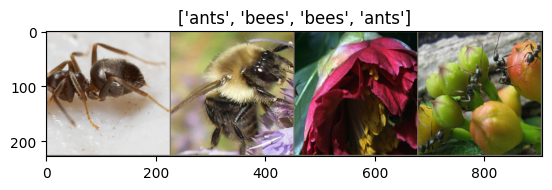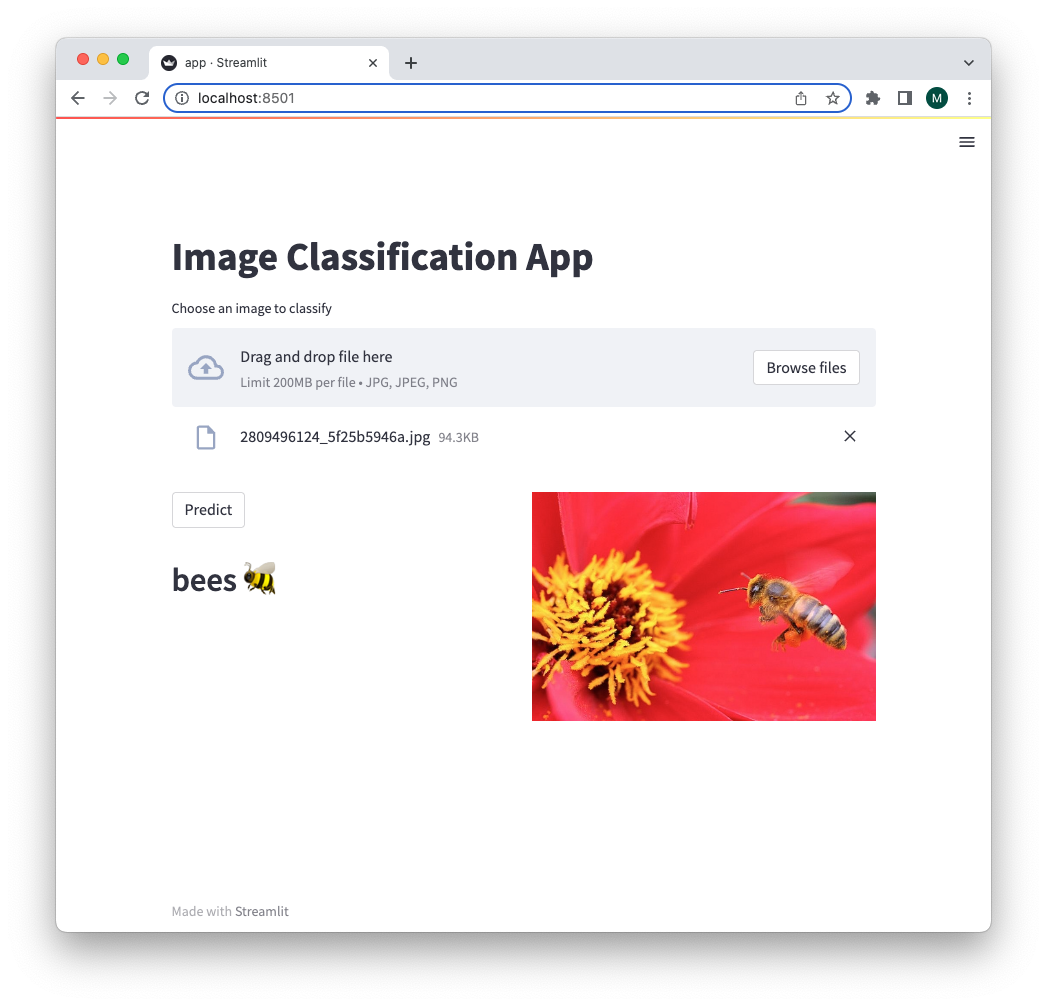How to make an image classification app
tl;dr
We will build an app, using deep learning, that can classify (ants and bees) images with an accuracy of 96%.
Introduction
In this tutorial, we deploy a deep learning model for image classification using transfer learning. The problem that we are going to solve is to classify images of ants and bees. For that, we use PyTorch to train the model and Streamlit to provide a UI to interact with the model.
Setup
import torch
import torch.nn as nn
import torch.optim as optim
import numpy as np
import torchvision
from torchvision import transforms
import matplotlib.pyplot as plt
import time
import copy
import pathlib
import requests
import zipfile
Data
We will download 120 training images—a subset of ImageNet—for each of ants and bees and also, 75 validation images for each class. If we were going to do the classification from scratch, we would need to collect a lot more data, but since we are using transfer learning, we can get away with a small dataset.
The dataset requires 45.2 MB of disk space.
def download(url, path: pathlib.Path, unzip=False, remove_zipped=False):
"""Download a file from url to path and potentially unzip it.
Args:
url (str): url to download from
path (pathlib.Path): path to download to
unzip (bool, optional): unzip the file. Defaults to False.
remove_zipped (bool, optional): remove the zipped file. Defaults to
False.
"""
# create path if not exists
if not path.is_file():
path.parent.mkdir(parents=True, exist_ok=True)
# add zip extension
if unzip:
path = path.with_suffix(".zip")
# download
r = requests.get(url, stream=True)
total_len = int(r.headers.get("content-length"))
chunk_size = 1024
count = 0
with open(path, "wb") as f:
for chunk in r.iter_content(chunk_size=chunk_size):
if chunk:
f.write(chunk)
count += 1
print(
f"Downloaded {count*chunk_size/total_len*100.0:.1f}%",
end="\r",
)
# unzip
if unzip:
with zipfile.ZipFile(path, "r") as zip_ref:
zip_ref.extractall(path.parent)
# remove zipped file
if remove_zipped:
path.unlink()
Download the dataset
Download the dataset and extract it to the current directory:
url = "https://download.pytorch.org/tutorial/hymenoptera_data.zip"
data_dir = pathlib.Path("hymenoptera_data")
if not data_dir.is_dir():
download(url, data_dir, unzip=True, remove_zipped=True)
Data augmentation and normalisation
Data augmentation and normalisation is done for training, and only data normalisation is performed for validation.
prep_img_mean = [0.485, 0.456, 0.406]
prep_img_std = [0.229, 0.224, 0.225]
data_transforms = {
"train": transforms.Compose(
[
transforms.RandomResizedCrop(224),
transforms.RandomHorizontalFlip(),
transforms.ToTensor(),
transforms.Normalize(mean=prep_img_mean, std=prep_img_std),
]
),
"val": transforms.Compose(
[
transforms.Resize(256),
transforms.CenterCrop(224),
transforms.ToTensor(),
transforms.Normalize(mean=prep_img_mean, std=prep_img_std),
]
),
}
image_datasets = {
x: torchvision.datasets.ImageFolder(
(data_dir / x).as_posix(), data_transforms[x]
)
for x in ["train", "val"]
}
dataloaders = {
x: torch.utils.data.DataLoader(
image_datasets[x], batch_size=4, shuffle=True, num_workers=4
)
for x in ["train", "val"]
}
dataset_sizes = {x: len(image_datasets[x]) for x in ["train", "val"]}
class_names = image_datasets["train"].classes
device = torch.device(
"cuda:0"
if torch.cuda.is_available()
else "mps"
if torch.backends.mps.is_available()
else "cpu"
)
Visualize sample images
Here we show some sample training images for ants and bees.
def imshow(inp, title=None):
"""Imshow for Tensor.
Args:
inp (Tensor): Tensor of shape (C, H, W) to plot.
title (str): Title of the plot.
"""
mean = np.array(prep_img_mean)
std = np.array(prep_img_std)
inp = inp.numpy().transpose((1, 2, 0))
inp = std * inp + mean
inp = np.clip(inp, 0, 1)
plt.imshow(inp)
if title:
plt.title(title)
plt.pause(0.001) # pause a bit so that plots are updated
# get a batch of training data
inputs, classes = next(iter(dataloaders["train"]))
# make a grid from batch
out = torchvision.utils.make_grid(inputs)
imshow(out, title=[class_names[x] for x in classes])

Train
The following is a generic function to train a model.
def train_model(model, criterion, optimizer, scheduler, num_epochs=25):
"""Train a model.
Args:
model: model to train
criterion: loss function
optimizer: optimizer
scheduler: learning rate scheduler
num_epochs: number of epochs to train for
Returns:
model: trained model
"""
since = time.time()
best_model_weights = copy.deepcopy(model.state_dict())
best_accuracy = 0.0
for epoch in range(num_epochs):
print(f"Epoch {epoch+1}/{num_epochs}")
print("-" * 10)
# each epoch has a training and validation phase
for phase in ["train", "val"]:
if phase == "train":
model.train() # set model to training mode
else:
model.eval() # set model to evaluate mode
running_loss = 0.0
running_corrects = 0
# iterate over data
for inputs, labels in dataloaders[phase]:
inputs = inputs.to(device)
labels = labels.to(device)
# zero the parameter gradients
optimizer.zero_grad()
# forward
# track history if only in train
with torch.set_grad_enabled(phase == "train"):
outputs = model(inputs)
_, preds = torch.max(outputs, 1)
loss = criterion(outputs, labels)
# backward + optimize only if in training phase
if phase == "train":
loss.backward()
optimizer.step()
# statistics
running_loss += loss.item() * inputs.size(0)
running_corrects += torch.sum(preds == labels.data)
if phase == "train":
scheduler.step()
epoch_loss = running_loss / dataset_sizes[phase]
epoch_acc = running_corrects.float() / dataset_sizes[phase]
print(
f"{phase}\tloss: {epoch_loss:.3f}, accuracy: {epoch_acc:.3f}"
)
# deep copy the model
if phase == "val" and epoch_acc > best_accuracy:
best_accuracy = epoch_acc
best_model_weights = copy.deepcopy(model.state_dict())
print()
time_elapsed = time.time() - since
print(
"Training completed in "
f"{time_elapsed // 60:.0f}m {time_elapsed % 60:.0f}s"
)
print(f"Best val accuracy: {best_accuracy:.3f}")
# load best model weights
model.load_state_dict(best_model_weights)
return model
ConvNet as fixed feature extractor
Here, we freeze all the convolutional neural network (ConvNet) except the final fully connected layer.
the regnet_x_3_2gf model weights need 15.3 MB of disk space.
model_conv = torchvision.models.regnet_x_3_2gf(
weights=torchvision.models.RegNet_X_3_2GF_Weights.IMAGENET1K_V2
)
for param in model_conv.parameters():
param.requires_grad = False
# parameters of newly constructed modules have requires_grad=True by default
num_features = model_conv.fc.in_features
model_conv.fc = nn.Linear(num_features, len(class_names))
model_conv = model_conv.to(device)
# loss function
criterion = nn.CrossEntropyLoss()
# only parameters of final layer are being optimized
optimizer_conv = optim.SGD(model_conv.fc.parameters(), lr=0.001, momentum=0.9)
# decay learning rate (LR) by a factor of gamma=0.1 every step_size=3 epochs
exp_lr_scheduler = optim.lr_scheduler.StepLR(
optimizer_conv, step_size=3, gamma=0.1
)
Train and evaluate
In this mode, gradients aren’t computed for most of the network, but forward is computed.
model_conv = train_model(
model=model_conv,
criterion=criterion,
optimizer=optimizer_conv,
scheduler=exp_lr_scheduler,
num_epochs=6,
)
which results in
Epoch 1/6
----------
train loss: 0.526, accuracy: 0.795
val loss: 0.343, accuracy: 0.948
Epoch 2/6
----------
train loss: 0.324, accuracy: 0.889
val loss: 0.344, accuracy: 0.935
Epoch 3/6
----------
train loss: 0.372, accuracy: 0.832
val loss: 0.235, accuracy: 0.948
Epoch 4/6
----------
train loss: 0.355, accuracy: 0.848
val loss: 0.206, accuracy: 0.961
Epoch 5/6
----------
train loss: 0.284, accuracy: 0.922
val loss: 0.220, accuracy: 0.922
Epoch 6/6
----------
train loss: 0.319, accuracy: 0.857
val loss: 0.257, accuracy: 0.954
Training completed in 4m 44s
Best val accuracy: 0.961
As can be seen, the best validation accuracy is 96% 👍.
Save the model for later deployment in Streamlit. It requires 57.6 MB of disk space on my MacBook M1 machine.
saved_model_name = "model_img_class.pt"
torch.save(model_conv, saved_model_name)
App
Here is the fun part!
We make an app, using Streamlit, to interact with the model we just trained.
You can create a file named app.py and insert the following code into it, or if you’re using Jupyter Notebook, insert %%writefile app.py right before the first line and press Enter.
import streamlit as st
import torch
from torchvision import transforms
from PIL import Image
import argparse
CLASS_NAMES = ["ants", "bees"]
MODEL_NAME = "model_img_class.pt"
def predict(model_name, img_path):
# load the model
model = torch.load(model_name, map_location="cpu")
# preprocess the image
prep_img_mean = [0.485, 0.456, 0.406]
prep_img_std = [0.229, 0.224, 0.225]
transform = transforms.Compose(
[
transforms.Resize(256),
transforms.CenterCrop(224),
transforms.ToTensor(),
transforms.Normalize(mean=prep_img_mean, std=prep_img_std),
]
)
image = Image.open(img_path)
preprocessed_image = transform(image).unsqueeze(0)
# predict the class
model.eval()
output = model(preprocessed_image)
pred_idx = torch.argmax(output, dim=1)
predicted_class = CLASS_NAMES[pred_idx]
return predicted_class
def create_app(model_name):
# title
st.title("Image Classification App")
# file uploader
uploaded_file = st.file_uploader(
"Choose an image to classify", type=["jpg", "jpeg", "png"]
)
if uploaded_file is not None:
st.write("")
# predict the class
predicted_class = predict(model_name, uploaded_file)
col_left, col_right = st.columns(2)
# the Predict button with the predicted class
with col_left:
if st.button("Predict"):
emoji = ":honeybee:" if predicted_class == "bees" else ":ant:"
st.markdown(f"## {predicted_class} {emoji}")
# display the image
with col_right:
image = Image.open(uploaded_file)
st.image(image)
def parse_args():
parser = argparse.ArgumentParser()
parser.add_argument(
"--model", type=str, help="model name", default=MODEL_NAME
)
args = parser.parse_args()
return args
if __name__ == "__main__":
args = parse_args()
create_app(model_name=args.model)
Now, we got all the required code and data and can run the app with Streamlit.
Streamlit is an open-source Python library that makes it easy to create and share beautiful, custom web apps for machine learning and data science. In just a few minutes you can build and deploy powerful data apps.
Running the app, with the following command in terminal, will open a browser tab on localhost:8501.
streamlit run app.py
